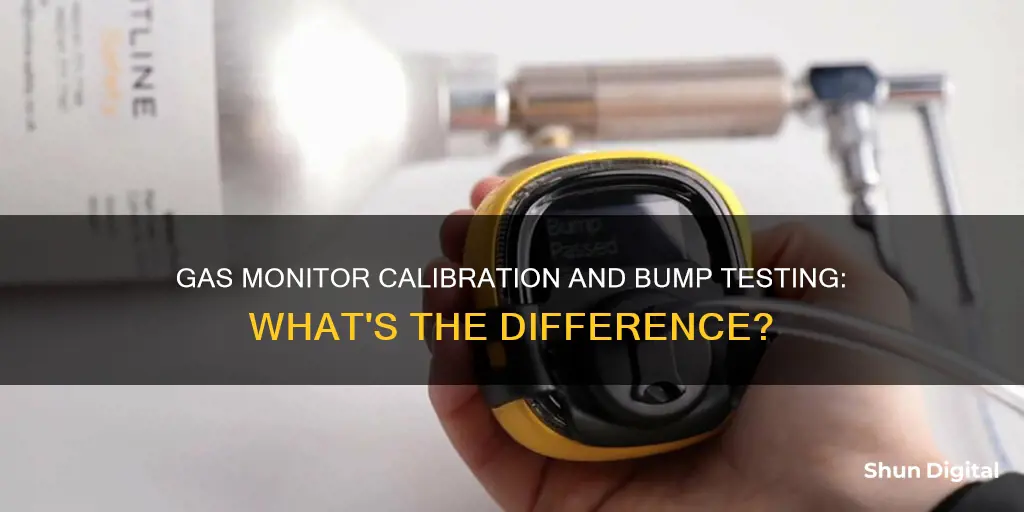
Gas monitors are important tools used to protect people from hazardous gases and other airborne substances that can cause injury, illness, or even death. To ensure these monitors are working effectively, they need to be calibrated and bump tested regularly. But what is the difference between calibration and bump testing? This article will explore the key distinctions between these two processes and explain why both are necessary to maintain the accuracy and reliability of gas monitors.
| Characteristics | Values |
|---|---|
| Purpose | Calibration checks the accuracy of the gas monitor's readings. Bump testing checks that the gas monitor's sensors and alarms are working. |
| Process | Calibration involves exposing the monitor to a known concentration of calibration gas or test gas for a specific amount of time. Bump testing involves exposing the monitor's sensors to a concentration of gas that is greater than the alarm set points. |
| Frequency | Calibration should be done regularly, e.g. monthly or according to the manufacturer's recommendations. Bump testing should be done before each use. |
| Equipment | Calibration requires calibration gas, tubing, a docking station or manual calibration. Bump testing requires a docking station, a gas bottle, a regulator, tubing, and a calibration cup. |
What You'll Learn

Calibration and bump testing are both required before using a gas monitor
Calibration and bump testing are both essential procedures that must be conducted before utilising a gas monitor to guarantee its functionality and accuracy in detecting hazardous gases. Gas monitors are critical safety tools in various industries, particularly oil and gas, where workers face the risk of exposure to toxic gases, oxygen-deficient environments, and other airborne substances that can cause severe health issues or even death.
Calibration serves as the cornerstone of accurate gas detection. By exposing the monitor to a known concentration of calibration gas, the device's sensors are fine-tuned to respond accurately to specific gas levels. This process establishes a reference point for future readings, ensuring that the monitor's measurements are precise. Calibration is especially crucial for older devices, as sensors degrade over time, and for devices that have been physically impacted, such as being dropped or damaged. Additionally, factors like temperature, humidity, and atmospheric pressure can influence sensor responsiveness, emphasising the importance of calibrating in environmental conditions similar to the worksite.
Bump testing, on the other hand, is a rapid verification process that ensures the gas monitor's functionality. It involves exposing the sensors to a target gas to confirm that the monitor will detect the gas and activate an alarm in a work environment. Bump testing does not assess accuracy but instead focuses on the operational capability of the monitor. This procedure is recommended before daily use and serves as a vital safety check. If a bump test fails, it indicates the need for a full calibration of the device.
Both calibration and bump testing play complementary roles in ensuring the reliability of gas monitors. Calibration sets the accuracy standard, while bump testing provides a quick operational check. By conducting both procedures, users can have confidence in the monitor's ability to detect hazardous gases and provide timely alerts, ultimately safeguarding their health and well-being in potentially dangerous work environments.
To streamline the processes of calibration and bump testing, docking stations can be employed. These stations automate the testing and charging of gas monitors, making it convenient to perform these critical tasks regularly. Additionally, docking stations can be integrated with software that schedules tests, notifies users, and maintains calibration records, further enhancing the efficiency and compliance of gas monitor maintenance.
Easy Ways to Remove Glucose Monitors from Your Arm
You may want to see also

Calibration is necessary to check the accuracy of readings
Calibration and testing reveal how reliable and accurate your gas monitor is. Air monitor calibration and testing are done with a known, traceable concentration of hazardous gas to ensure that the monitor sensors are responding accurately and that the alarms function. Once calibrated, the instrument's meters are reset to match the test gas, ensuring that all readings are accurate.
The responsiveness of monitor sensors can vary depending on workplace conditions such as temperature, humidity, and atmospheric pressure. Therefore, it is important to calibrate sensors in environmental conditions as close to the worksite conditions as possible. Calibration drift occurs when an instrument's reference point shifts, causing the reading to shift and become unreliable. This happens to all sensors over time. Calibration checks or full calibration with a traceable gas concentration will verify or update the instrument's reference point.
Operators should conduct these procedures daily, or more frequently if needed, to ensure that the instrument will continue to produce accurate readings. Calibration is especially important for older devices, as sensors will degrade over time and use. A device that cannot accurately read set values needs to be replaced. Any devices that have been dropped or otherwise damaged should be recalibrated.
Bump testing verifies that your gas monitor will detect the target gas in a work environment. It does not, however, adjust the accuracy of the measurement. When performing a bump test, the test gas concentration should be high enough to trigger the instrument alarm. If the bump test results are not within the acceptable range, a full calibration must be performed.
Monitors and Performance: Multiple Displays, Impacting Productivity?
You may want to see also

Bump testing verifies that a gas monitor's sensors and alarms are working
Gas monitors are essential in many industries, especially oil and gas, as they protect workers from hazardous gases and other airborne substances that can cause injury, illness, or even death. These substances are often odorless, colorless, and tasteless, making them impossible to detect without a gas detector. To ensure the effectiveness of these devices, it is crucial to perform regular calibration and bump testing. While both processes are necessary, they serve different purposes.
The basic steps for bump testing a gas monitor include:
- Placing the gas detector in bump test mode or turning it on.
- Exposing the sensors to the target gas by using a clip and clear hose attached to the calibration gas and regulator.
- Allowing the gas to flow until the monitor goes into alarm, which usually takes no more than 20 seconds.
- Turning off the gas and storing the equipment for the next test.
Alternatively, manual bump testing can be performed by simply applying gas to the instrument while it is on the main gas reading screen. If each sensor responds to the gas and the alarm is activated, the gas monitor is functioning correctly.
To facilitate bump testing, docking stations can be used. These stations automatically apply gas to the docked detector, charge the device, and perform other maintenance tasks. They can also be connected to software that schedules bump tests and notifies users in case of any failures.
LED vs LCD: Which Monitor is Superior?
You may want to see also

Calibration drift occurs in all sensors over time
Calibration and bump testing are both important procedures for gas monitors to ensure they are functioning properly and accurately. While bump testing is a quick check to ensure the device will detect the target gas, calibration is a more in-depth process that adjusts the instrument's reading to coincide with a known concentration of test gas.
Calibration drift, also known as measurement drift, is a natural phenomenon that occurs in all sensors over time. It refers to the gradual shift in a sensor's measured values, causing the reading to become unreliable. This can be caused by various factors, including degradation of components, exposure to extreme environmental conditions, and incorrect handling. For example, in the case of a bathroom scale, a zero drift would cause the scale to display a reading of 1 kg even when no one is standing on it. If a person weighing 70 kg steps on the scale, the reading would be 71 kg instead of the correct weight.
To compensate for calibration drift, it is essential to perform regular calibration checks or full calibrations. These procedures help verify or update the instrument's reference point, ensuring accurate readings. The frequency of calibration can vary depending on the specific instrument and its usage. For some sensors, annual calibration may be sufficient, while others might require calibration before each use. It is crucial to refer to the manufacturer's guidelines and recommendations for proper calibration procedures and frequency.
In addition to calibration, bump testing is also an important step in maintaining the accuracy of gas monitors. Bump testing involves exposing the sensors to the target gas to ensure that the monitor will go into alarm if exposed to the gas in the field. This quick test can be easily performed daily before using the device and provides an extra layer of assurance that the gas monitor is functioning properly.
Setting Up Near-Field Monitors: Calibrating Your Room for Audio Precision
You may want to see also

Bump testing is recommended before each use
Gas monitors are essential in protecting workers from hazardous gases and other airborne substances that can cause injury, illness, or even death. To ensure the safety of workers, it is crucial to perform bump testing before each use. Bump testing is a simple and quick process that verifies the functionality of a gas monitor's sensors and alarms. By exposing the sensors to a known concentration of gas that is higher than the alarm set points, we can confirm that the gas monitor will go into alarm as expected. This is especially important because gas monitors are often subjected to harsh environments, including extreme temperatures, humidity, and physical impacts, all of which can affect their performance.
The basic steps of a bump test involve securing a clip and clear hose to the sensor plate of the gas monitor, connecting the other end of the hose to the calibration gas and regulator, and then allowing the gas to flow until the monitor triggers an alarm. This entire process should take no more than 20 seconds. Performing this test before each use ensures that the gas monitor is ready to protect workers from hazardous gases.
In addition to bump testing, regular calibration of gas monitors is also necessary. Calibration checks the accuracy of gas readings by exposing the monitor to a known concentration of calibration gas for a specific amount of time. This reading becomes the reference point for future gas detections. Calibration is crucial because sensors can drift over time, leading to inaccurate readings. While bump testing ensures the functionality of the gas monitor, calibration ensures the accuracy of its readings.
By combining bump testing before each use with regular calibration, workers can trust that their gas monitors are fully functional and providing accurate information about the presence of hazardous gases. This two-pronged approach is key to maintaining safety in workplaces where hazardous gases are a constant threat.
To streamline the process, docking stations can be used to automatically perform bump tests and calibrations, as well as charge the gas monitors and conduct other maintenance tasks. This technology not only saves time but also ensures that the necessary checks are consistently performed before each shift.
Erasing Images: Monitor Maintenance 101
You may want to see also
Frequently asked questions
A bump test is a simple process where you expose sensors in a gas detector to an expected concentration of gas that is greater than the alarm set points. If everything is working as expected, the gas detector will go into alarm. Bump testing is the only way to ensure that a gas detector's sensors and alarms are working.
Calibration and testing tell you how reliable and accurate your gas monitor is. Air monitor calibration and testing are done with a known, traceable concentration of hazardous gas to ensure that the monitor sensors are responding accurately and that the alarms function.
Bump testing and calibration are both necessary to verify gas monitor functionality before use. Bump testing verifies that your gas monitor will detect the target gas in a work environment. Calibration is necessary to check the accuracy of your readings. This process allows instruments to self-correct to the appropriate level of sensitivity.
Bump testing should take place on a daily basis before the device is used. Calibration should be done at least once a month to ensure accurate readings.







